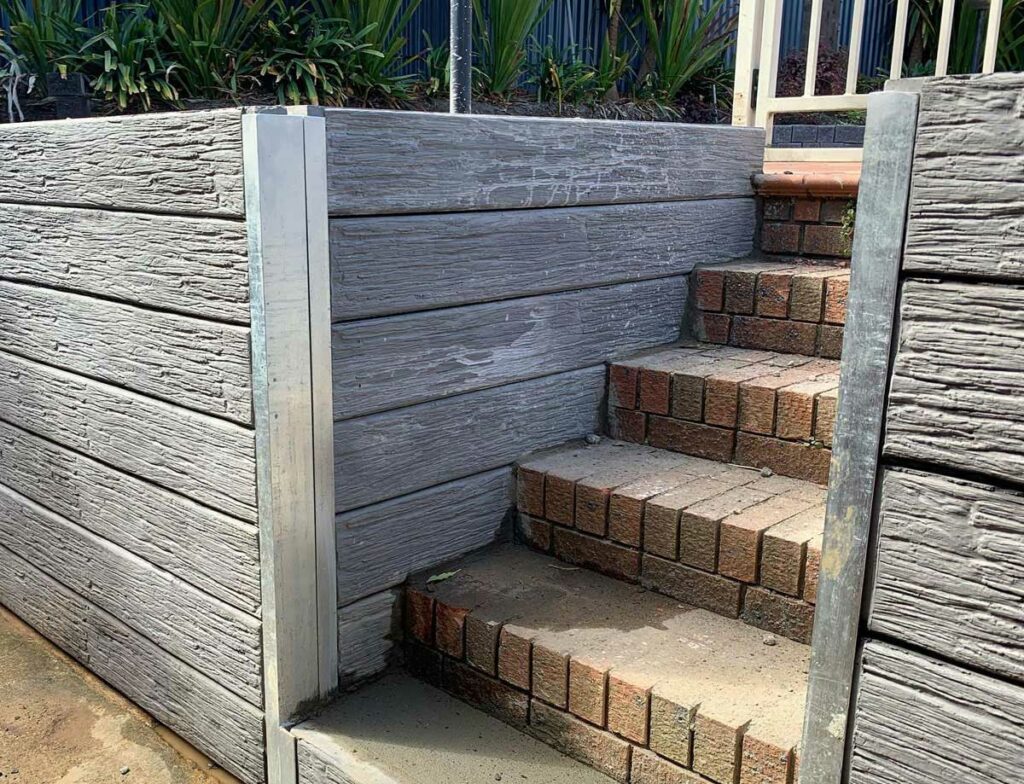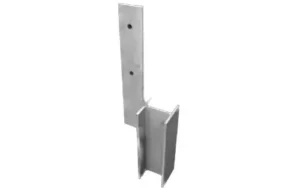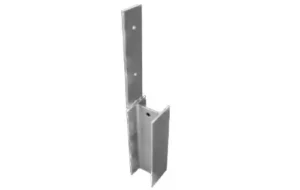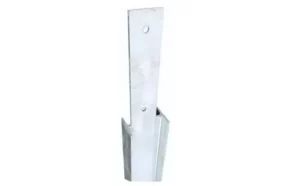Steel post retaining walls are incredibly robust, designed to withstand even the most challenging terrains. While they might seem intimidating at first, there’s no need to worry. We’re here to guide you every step of the way, ensuring you can confidently construct your ideal structure. With our comprehensive step-by-step guide, you’ll not only understand the process but also enjoy building your steel post retaining wall. Ready to get started? Let’s embark on this journey together!

At Concrete Sleepers Melbourne we take pride in offering a wide range of steel posts to cater to your specific needs for retaining walls and fencing projects. Our selection includes the robust and load-bearing H Beam Retaining Wall Steel, perfect for heavy-duty applications where strength is paramount. Additionally, we provide the versatile C Channel Steel, which combines durability and adaptability, allowing for seamless integration into various retaining wall designs.
To address precise angles, we offer 45 Degree Corner Channel Posts and 90 Degree Corner Channel Posts, ensuring secure connections at corners with a seamless finish. We also offer Fencing Steel, providing a reliable solution for blending fencing systems with retaining walls, balancing functionality and aesthetic appeal. With our diverse array of steel posts, we strive to provide you with high-quality options that meet your specific project requirements.
Steel Post Retaining Wall Construction
Constructing a steel post retaining wall is a valuable addition to home landscaping. These walls not only stabilize soil and rocks but also enhance your yard’s aesthetics. Known for their durability, steel post walls offer lasting support, often outliving the house itself. Their construction is straightforward, primarily requiring posts and reinforcement materials like concrete footings, rods, and plates. Yet, precision is crucial to ensure the wall’s stability.
However, there are challenges. Over time, steel can rust, and improper drainage can lead to soil erosion around the wall. But with regular maintenance and correct installation techniques, these issues can be mitigated. For instance, using galvanized posts and incorporating drainage features can be beneficial.
Building a steel post retaining wall demands meticulous attention during both material selection and installation. With the right construction and maintenance knowledge, these walls can significantly enhance your home’s landscape while providing sturdy support. Let’s delve into the materials and steps involved.
Materials and Supplies Needed
Before starting, gather all necessary materials:
- Flat-edged shovel
- Wheelbarrow
- Landscape fabric
- Concrete mix
- Level
- Type S masonry mortar mix
- Steel post anchors
- Auger (with at least 7’ digging depth)
- Steel posts (matching the wall’s height)
While some might argue about the cost and effort of procuring these supplies, their importance in constructing a durable wall is undeniable. Quality materials can prevent issues stemming from poor construction.
Preparing the Foundation for the Retaining Wall
A solid foundation is paramount. Begin by excavating the soil where the wall will stand and pour concrete footing strips. Depending on the climate and soil type, you might need to dig below the frost line or use gravel for post stability. Reinforcements like rebar or geogrids can also be added for extra strength. Once the area is prepared, pour concrete footings to anchor the posts.
Choosing the Location for the Retaining Wall
Selecting the right spot is crucial. Consider factors like nearby trees, water runoff, soil type, and existing structures. Think about traffic patterns and potential obstructions. A well-chosen location can enhance your yard’s overall look.
Installing Steel Post Retaining Wall Posts
With the location set, it’s time to install the posts. Proper placement is vital for the wall’s stability. Use concrete footings and post anchors for a firm foundation. Ensure all posts are level and straight before proceeding.
Adding Vertical and Horizontal Members
After the main posts are up, install vertical members between them. Then, secure horizontal members on both sides. You can use wood or steel panels, each with its own pros and cons. Ensure all components are fastened securely with galvanized fasteners.
Connectors and Beams
These elements provide stability. Use angle brackets for simpler connections and gusset plates for added strength. Depending on the project’s size, choose between I-beams or T-beams for additional support.
Fastening System
A robust fastening system ensures the wall’s longevity. Common systems include lag screws, through bolts, riser flanges, and washers. Each has its advantages, so choose based on your project’s specific needs.
In conclusion, while building a steel post retaining wall requires effort and precision, the result is a durable and aesthetically pleasing structure that enhances your home’s landscape.
Fastening System for Steel Post Retaining Walls
After installing connectors and beams for a steel post retaining wall, selecting the right fastening system is crucial. This system should be robust enough to withstand external forces like gravity, water pressure, and earth movement.
Popular fastening choices include:
- Lag Screws: Ideal for creating tension and stability. They take longer to install but offer superior tensile strength.
- Through Bolts: A quicker alternative to lag screws, especially for unstable grounds. However, they might loosen over time due to external vibrations.
- Riser Flanges: Add strength and a decorative touch. They require deep drilling for secure installation.
- Washers: Simple tools that enhance connection strength by distributing pressure.
Each system has its pros and cons. For instance, while lag screws provide strength, they’re time-consuming to install. Through bolts are faster but might loosen over time. Riser flanges beautify the structure but need deep drilling, and washers, while effective, might need more force during tightening.
In conclusion, the best fastening system varies per project. It’s vital to evaluate each option’s strengths and weaknesses to choose the most suitable for your construction needs.
Answers to Common Questions
What is the best way to set the steel posts for the wall?
The optimal method to set steel posts for a wall is by employing an anchor or bolt system. Here, posts are fitted into pre-drilled holes in the ground and anchored securely using concrete anchors or bolts. This ensures a sturdy foundation for the wall, safeguarding it from potential threats like frost heaving or soil shifts.
What materials will I need to construct a steel post retaining wall?
Constructing a steel post retaining wall requires a variety of materials:
- Steel Posts: The primary structural component.
- Foundation Materials: Stone, gravel, and mortar.
- Reinforcements: Steel brackets and structural connectors, like timber screws.
- Post Caps: Plastic or concrete options to cover the top of exposed posts.
- Finishing Touches: Cement caulk can be used to enhance the wall’s appearance.
Ensure you have all these materials on hand before starting the construction for a smooth building process.
What safety considerations should I keep in mind when constructing a steel post retaining wall?

Building a steel post retaining wall requires meticulous attention to safety. Here are some essential precautions to ensure a safe construction process:
- Personal Protective Equipment: Always wear protective eyewear and gloves, especially when using power tools or handling sharp materials like steel posts.
- Check for Utilities: Before digging, ensure the area is clear of electrical power lines or underground cables to prevent accidents.
- Accuracy is Key: Double-check all measurements for precision and ensure equal spacing between posts.
- Stabilize Your Structure: Use braces, crossbars, or other support systems to maintain the structural integrity of the posts during construction.
- Secure Anchorage: Properly anchor the posts into the ground to prevent movement from external forces like high winds.
- Seek Expert Advice: For complex sections or additional reinforcements, consult with a professional engineer to ensure the wall’s stability.
By adhering to these guidelines, you’ll ensure that your steel post retaining wall is not only visually appealing but also structurally robust and safe for all.




